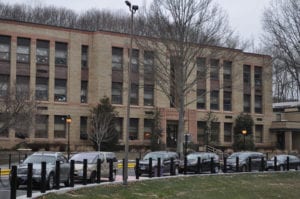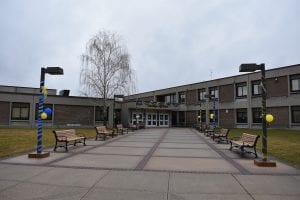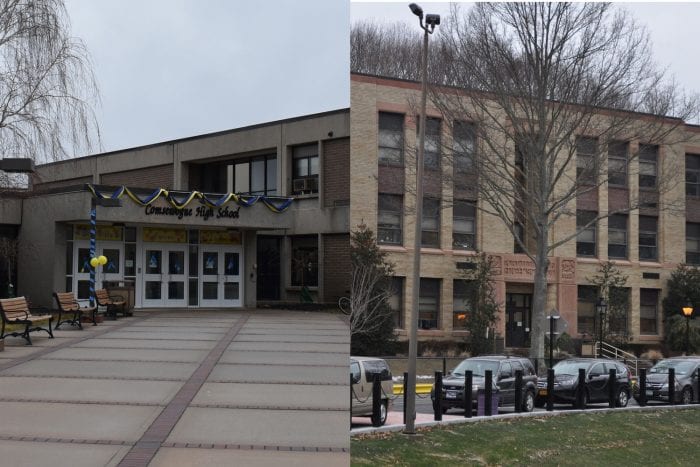PJ/Comsewogue Districts Present 2020-21 School Budgets
With school district budgets and board elections on the docket for June 9 with an extension from New York State, this year’s crop of district spending and revenue plans have had to contend with many unknowns.
In fact, budgets may change from now until June 1, as the current pandemic holds much in the air. COVID-19, by Gov. Andrew Cuomo’s (D) estimates, could result in approximately $61 billion less revenue for New York State from 2021 to 2024. The hope rests on the federal government supplying the state with emergency funding.
“It’s very, very hard to plan for the unknown,” said Glen Arcuri, the assistant superintendent for finance and operations at the Shoreham-Wading River Central School District.
The governor has three look-back periods for revising state aid. The last period is Dec. 31.
Though one certainty is the start of next school year will weigh heavily on officials, as many still do not know when students will again walk through facilities’ doors.
Additionally, complicating this year’s votes is everything must be done outside of polling locations. Suffolk County Board of Elections, based on an executive order, will mail ballots to each residence with a prepaid return envelope. A household may contact the district clerks for more information about ballots.
There are still many unknowns, even as districts craft budgets. Nobody could say whether students will have a fall sports season, whether students would have to wear masks and remain apart in the classroom, or whether there will even be the chance for students to learn in-person, instead
of online.
Numbers floated by Cuomo for state aid reductions have not inspired much hope. The governor said without state aid, school districts could see an upward of 50 percent reduction.
“A 50 percent reduction would be very painful for our school district, it would be insurmountable for any other school district,” said Port Jefferson Deputy Superintendent Sean Leister.
All that comes down to whether the federal government will provide aid to the state for it to maintain current budget figures.
All budget information provided is the latest from the school districts, though it is currently subject to change. If it does, an update to this article will appear in the June 4 issue.

Port Jefferson School District
The Port Jeff School District is for the most part staying to the course established by previous budget presentations.
Next year’s budget is looking at a 1.83 percent increase from last year for a total of $44,739,855. This year’s tax levy, or the amount raised through property taxes, is $37,356,454, a $457,630 or 1.24 percent increase from last year.
The district is expecting to receive $3,863,212 in state aid, a marked increase of 2.54 percent from last year. However, district officials said while the amounts have been set, there is no word on whether the state will reduce those amounts midstream into next school year.
“We’ll be working under a lot of uncertainty, from month to month to quarter to quarter,” Leister said.
Superintendent Jessica Schmettan said the district has been watching the “political push and pull” of state aid reductions closely.
“The swing in what that state aid is, is concerning to us, and the difficult part is it’s an unknown,” she said. “I think that needs to be drawn upon. There is a lot of advocacy happening to make sure there is some federal money to help with this large deficit.”
Leister added that legislation allowing the district to put aside unspent money from this year into next year’s in excess of legal reserve limits would also help.
Leister said this year’s budget increases are mainly due to the standard labor agreement increases, an increase in the retirement contribution rate and a decrease in debt services. Continuing building improvements included in the budget are the second part of the security vestibule capital project, a new replacement retaining wall to the technical education building, a replacement to the middle school heating system.
This year’s capital reserve will also be used for some of these projects, including $2 million for continuing work on the high school roof replacement project.
In terms of reserves, the district expects to use $3.4 million, leaving $14.5 million in reserve at the end of next year. This could be used “to help offset a reduction in state aid,” Leister said. “This is our rainy day funds, and I would definitely classify that as a rainy day.”
Because of the ongoing glide path due to the LIPA settlement, the district will experience a 3.5 percent loss. This is compared to last school year, where the loss was 6 percent. As a result of this smaller loss, there will be an extra $48,185 in power plant tax revenue at $1,477,185.
Enrollment is continuing on a downward path. In 2014, total enrollment sat at 1,197, which became 1,115 in 2018 and turns to 1,052 in 2020. Along those same lines, Port Jefferson is reducing staff by three teachers, and a total equivalent of five full-time employees overall. That is subject to change as scheduling goes on.
The district also provided estimates for tax rates based on a property’s assessed value. A home with a $12,500 assessed value could expect a $20,466 bill at the 3.5 percent tax rate. On the lower end, a home assessed at $1,600 would see a $2,620 bill. The budget hearing will be hosted May 12 at 7 p.m.
Ballots must be returned to the district clerk’s office no later than 5 p.m. June 9. Should additional ballots be required at a residence, the district clerk can be contacted by either email at [email protected] or by phone at 631-791-4221.

Comsewogue School District
Comsewogue district officials said they are taking their savings from not operating to the same extent the last few months and, instead of putting it into the fund balance, are carrying it over to next year, boasting that doing so results in a 0 percent tax increase.
District residents will be asked to vote on two propositions, one is the budget of $96,635,581 and the other is take $1,500,000 from the capital fund and use it for high school improvements including two synthetic turf fields for baseball and softball, high school boiler room HVAC repairs and otehr classroom renovations.
Associate Superintendent Susan Casali said the district is allocating an additional fund balance from operational savings from the closure of the buildings to this year’s budget, resulting in the no tax increase. Last year’s $57,279,755 tax levy, or the amount the district raises from area taxes, will then be this year’s as well.
Despite this, the budget largely remains the same from the district’s March presentations. The $96.6 million budget is an increase of 2.8 percent or $2,660,826.
“We still have to plan,” Casali said. “We’re assuming currently we’ll be opening on time in September.”
Overall, programming is set to remain the same, the associate super said. The biggest budget increases come from instructional costs, with $819,111 extra going to regular school instruction and an additional $803,412 for special education. The district is adding one full-time psychologist/social worker and one other full-time employee to the technology department.
The district is also adding an additional section to the fourth grade at Boyle Road Elementary.
In terms of state aid, the district is seeing a planned reduction of approximately $150,000, or -0.5 percent to $32,550,000. Last year the district received $32,700,000.
The question of whether or not the district will even receive the full amount of this reduced sum still depends on whether or not the state will hold onto its current budget.
Due to the rampant change in schedules for the actual budget and board of education vote, this year Comsewogue will be hosting its budget hearing June 1, with the actual vote scheduled for a week later, June 9.
Ballots must be given or posted for receipt by the clerk’s office in the state-issued return envelope by 5 p.m. June 9. Casali said it’s best for residents to catch the mail by June 2 to make sure it arrives on time.
This post was amended May 26 to better clarify the mail in ballots.







